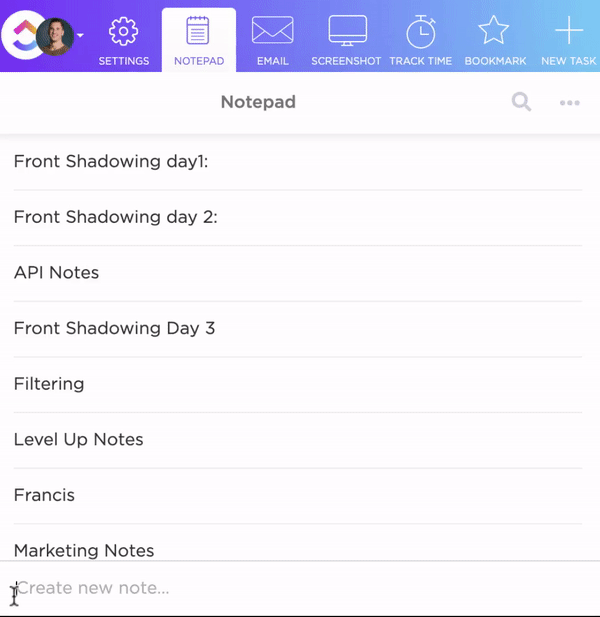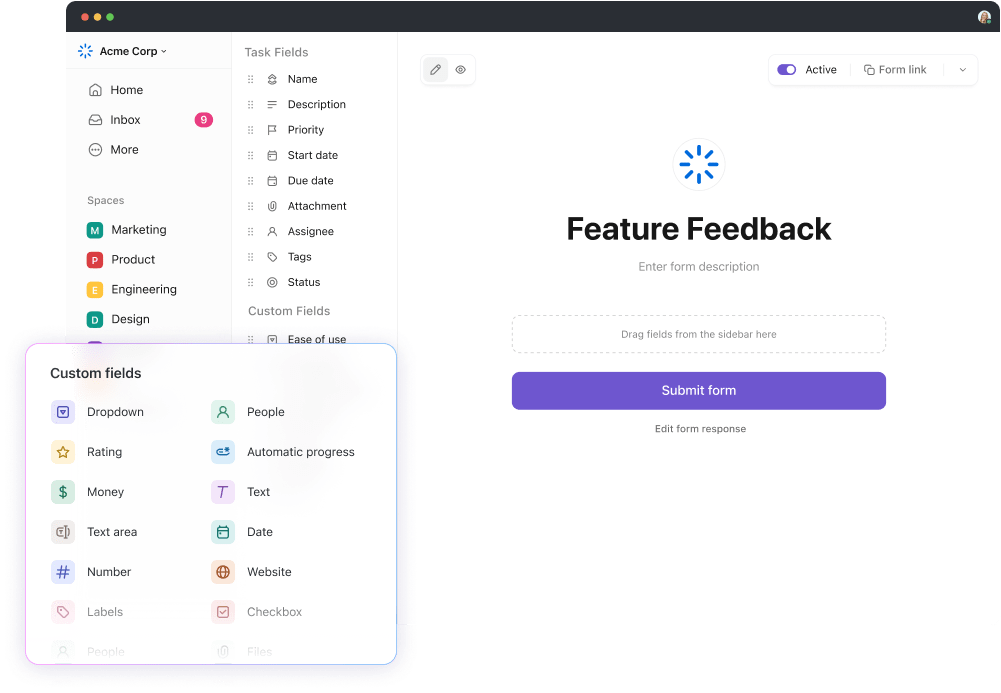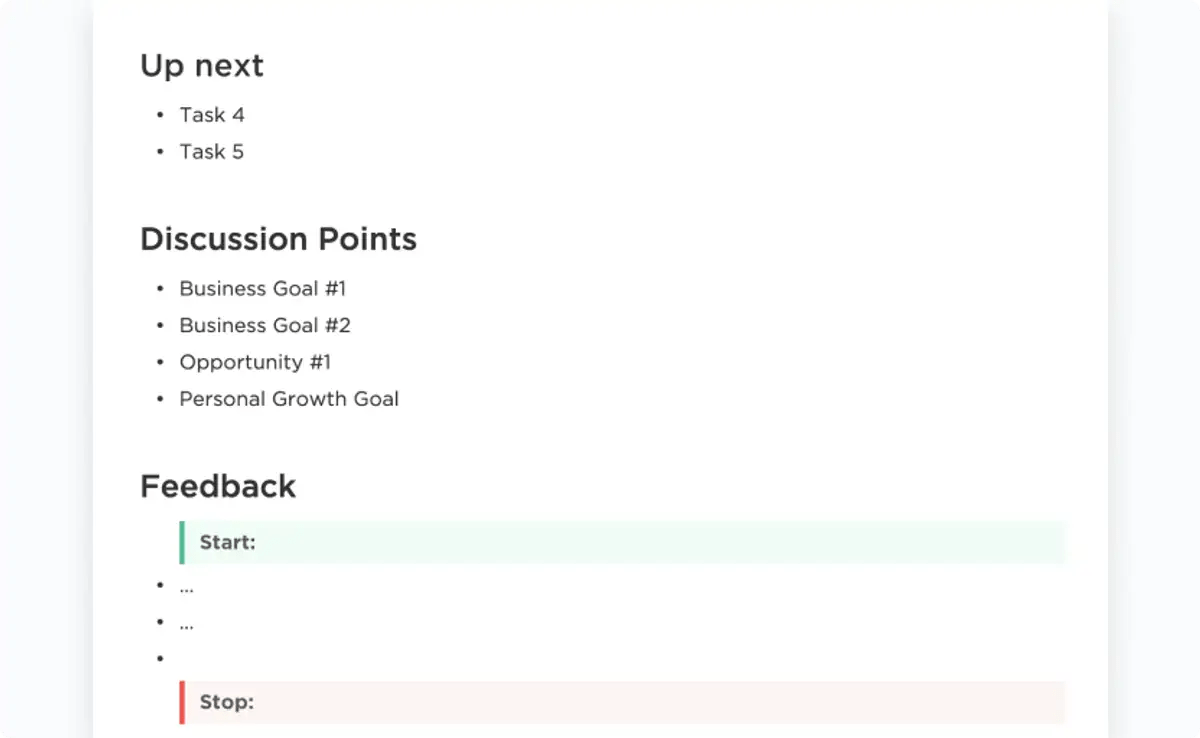

Did you know that when managers give daily feedback, employees are 3.6 times more likely to feel motivated to do outstanding work?
Feedback is a powerful tool that plays a significant role in the progress and success of any organization. It helps create a workplace where every voice is heard, every idea is valued, and every individual has the opportunity to grow and thrive.
A feedback session allows you to communicate openly and frankly with your team and boosts engagement. You can provide insights into areas for improvement, praise their strengths, and help them develop a plan that drives personal and professional growth.
However, holding a successful feedback session is more than just calling for a meeting. Both, annual performance reviews and ad hoc feedback sessions require some training and preparation. In this article, we will take you through the benefits and challenges of feedback sessions and the steps to holding a successful one.
- Benefits of Employee Feedback Sessions
- Challenges in Implementing Effective Feedback Sessions
- How to Plan an Effective Feedback Session?
- Feedback Session Templates
- The Role of Feedback Sessions in Enhancing Employee Retention and Performance
- Make Feedback Sessions Productive with ClickUp
- Frequently Asked Questions (FAQ)
Benefits of Employee Feedback Sessions
Holding regular feedback sessions can skyrocket your growth and team members’ engagement. Let’s look at some of the benefits of feedback sessions.
Motivates employees
Regular feedback is not just about sharing areas for improvement and weaknesses; it also involves praising and recognizing employees’ strengths and achievements. This helps motivate employees, makes them feel valued, and improves their self-esteem.
Promotes all-round development
Feedback sessions enable the all-round development of employees. The right feedback at the right time helps them analyze their performance, strengths, and areas for growth. Constructive feedback also promotes personal and professional development.
Resolves conflicts
Another benefit of regular feedback is its ability to resolve conflicts before they become significant issues.
Regular feedback sessions enable your team members to share their views and have difficult conversations with each other, including resolving minor misunderstandings that don’t seem like much at first thought. This prevents them from developing into full-blown conflicts.
Boosts engagement
Everyone wants to hear what they did well and how they can improve after working on a project. It is the same for your team. As per Gallup, 80% of employees say meaningful feedback helps them become fully engaged.
Engaged employees are more dedicated and enthusiastic about their work, thus improving success and retention rates.
Open communication
Frequent feedback develops a culture of open communication within your workplace. Encouraging it creates an environment where your team members can freely express their concerns and ideas.
It also helps them become open to criticism and appreciate positive feedback. And this ultimately improves collaboration and team dynamics.
Improves performance
Without constructive feedback, your team will not know what they’re doing well and what needs to be improved. A regular feedback process helps them improve their performance and be more motivated at work.
Similarly, feedback is crucial to determining your leadership strategy’s effectiveness. By communicating with your team members, you can improve your skills and choose the most effective strategy.
Challenges in Implementing Effective Feedback Sessions
Hesitation, biases, poor communication skills, and unclear goals are all challenges to implementing effective feedback sessions. Let us discuss how.
1. Lack of specific feedback
One of the most significant challenges is the lack of specific feedback. For example, saying, ‘Your presentation needs improvement,’ doesn’t clarify what aspect needs improvement. It can leave the feedback recipient confused.
How to overcome this challenge:
Focus on specific behaviors or outcomes to provide clear and actionable feedback. Instead of vague statements, offer concrete examples and suggestions.
A better feedback example in the above scenario would be saying, “Your presentation was informative, but there are areas you can improve. Some of your slides were cluttered with text, which made it difficult to follow the key points.”
This addresses which parts of the presentation need improvement.
2. Fear of negative reactions or confrontations
Another challenge managers often face is the fear of adverse reactions from team members. You may worry about demotivating your employees or damaging relationships. Similarly, fear of confrontation hinders honest and open communication.
Using a balanced approach while giving feedback is a must-develop leadership skill. Giving only negative feedback can lower employees’ morale and impact their desire to work. On the other hand, giving only positive feedback can result in complacency and hinder growth.
How to overcome this challenge:
Balance positive reinforcement and constructive criticism to foster a culture of continuous improvement and development. A respectful and balanced approach can enable a productive conversation.
3. Poor communication skills
Both givers and receivers of feedback may lack adequate communication skills. Poor communication skills make it difficult to express thoughts constructively or understand feedback without becoming defensive.
The feedback may be too personal. For example, instead of addressing the skills as a problem, it may address the employees themselves as a problem.
Conversely, feedback may be too impersonal. You may provide general feedback to the entire team instead of addressing each individual and their specific challenges.
How to overcome this challenge:
- Consider investing in training programs to enhance communication skills for feedback givers and receivers.
- Offer guidance on effective communication techniques, active listening, and providing feedback in a constructive and empathetic manner.
4. Bias and subjectivity
Unconscious biases and micromanaging team members often influence feedback, leading to unfair or inaccurate assessments. One example of this is confirmation bias. If a manager believes that an employee lacks initiative, they may selectively notice instances supporting this belief while ignoring evidence.
Moreover, subjective opinions may also overshadow objective observations. This affects the quality and validity of feedback.
How to overcome this challenge:
- Create a culture of safety and zero judgment for feedback sessions.
- Help create awareness of unconscious biases and encourage objective evaluation criteria in feedback sessions.
- Ensure that feedback is based on merit and performance rather than personal preferences.
Time constraints
Sometimes, managers get too busy to give regular and frequent feedback to team members, leaving it till the final performance review discussion. Sharing feedback long after a situation has passed typically has no benefits. Your team members may not even clearly remember the situation.
Feedback must be shared at the right time and frequency to be constructive. Delaying the feedback may impact the employee’s performance.
For example, if a project has been completed, you must promptly appreciate the employee’s achievement. Similarly, if a team member has made a mistake during work, you must address it early to prevent them from making the same mistake.
How to overcome this challenge:
Schedule sessions periodically to review employees’ performance and address issues. This will also help encourage a growth mindset and a commitment to continuous improvement and learning. You can use performance review software to schedule these sessions promptly.
Setting unclear goals and expectations
It is crucial to set clear goals and expectations for feedback sessions. Unclear goals may confuse the employees about the purpose and expected outcomes of the session. They may give and receive unclear and unactionable feedback.
How to overcome this challenge:
Define clear objectives for each feedback session. Outline what needs to be discussed, the purpose of the feedback, and the desired outcomes. It is best to set goals collaboratively, ensuring they align with the organizational goals and objectives.
How to Plan an Effective Feedback Session?
Now that you are armed with the strategies to conduct feedback sessions, here are the next steps you should follow to hold one:
Define objectives
The first step is to define your objectives. Are you planning a comprehensive feedback meeting or a short, one-on-one session? Are you providing performance feedback, continuous support, and coaching for skills improvement or addressing specific issues or challenges?
Identify specific goals, outcomes, and areas of focus for discussion. Your objectives can depend on the context of the feedback session, such as self-assessment, performance evaluation, project debriefing, or skill development.
While defining objectives for the feedback conversation, ensure they are specific and measurable. Also, the needs, preferences, and development goals of the people involved in the feedback session should be considered. This will help you give relevant and meaningful feedback to each participant.
Choose the right format
Determine who should participate in the feedback session based on the objectives and the individuals involved. This may include managers, supervisors, peers, or other stakeholders.
Once the participants have decided on a format and place for the session, It can be a one-on-one meeting, group discussion, formal presentation, or informal conversation.
Finally, schedule the session at everyone’s convenience.
Offer context and guidelines
Communicate clear expectations to all participants regarding the scope and objectives of the feedback session. Offer context for the session by explaining its purpose, importance, and expected outcomes.
Further, establish guidelines for giving and receiving feedback, emphasizing respect, honesty, and constructive criticism. Use software like ClickUp to share information to ensure everyone is on the same page.

💡Tip: ClickUp Docs offers real-time editing, powerful formatting features, nested pages, easy searchability, and secure sharing. You can smoothly share the guidelines with all the participants, tag them in specific areas, add comments, and manage permissions.
Prepare feedback givers and receivers
If you’re planning a team feedback session, offer guidance to feedback givers on delivering feedback effectively. You can share examples of constructive feedback and encourage them to focus on specific behaviors, observations, and actionable suggestions.
Further, prepare participants to receive feedback by setting expectations and encouraging them to listen, ask clarifying questions, and be open.
If you’re planning one-on-one sessions, prepare examples and evidence to support the feedback you are giving. Use relevant data and goals to support your words.
Facilitate the session
The next step is to facilitate the session. Ensure it stays focused, productive, and respectful. Your most essential jobs are to keep the conversation on track, encourage participation from all participants, and manage any conflicts or misunderstandings that may arise.
Begin on a positive note and create a welcoming environment. Establish ground rules and encourage active participation by asking team members to share their experiences and feedback openly.
Create opportunities for everyone to contribute to the discussion. Encourage employees to share their self-evaluation and actively listen to their thoughts. Guide the discussion by posing relevant questions, summarizing key points, and redirecting the conversation if it veers off-topic.
Document and follow-up
Take notes during the feedback session to document key points, action items, and follow-up tasks. Share the meeting recap with all the participants, including the summary of the session and action plans. A written document ensures everyone is on the same page.

💡Tip: You can use an online shareable notepad like ClickUp Notepad to record the meeting minutes quickly. Use rich editing features to format your notes, share them with your team, and access them from any device.
Encourage reflection and an action plan
After discussing feedback, encourage participants to take some time for self-reflection. Ask them to consider the feedback they’ve received and reflect on their strengths, areas for improvement, and any valuable insights gained from the discussion.
Go further by helping your team members develop action plans based on the feedback received. To simplify this process, use a tool like ClickUp Brain. Brain lets you summarize discussions, docs, task threads, and updates. You can also get action points and insights from your discussion to help you develop the action plan.
With the plan ready, help your team members identify specific actions they can take to address areas for improvement or capitalize on their strengths. This also involves establishing clear timelines for implementation.
Further, offers resources like coaching, mentoring, professional development opportunities, and access to relevant tools.
💡Tip: Use Mindmaps in ClickUp to organize and visualize your thoughts

Remember to schedule follow-up sessions or check-ins to review progress on action plans and provide additional support as needed. You can also use these opportunities to celebrate successes and adjust action plans.
Ask for their feedback
Lastly, encourage your team to share their feedback after the session. Ask about the session’s effectiveness, format, and facilitation. Use this feedback to refine future feedback meetings and improve the overall process. You can also use 360 Feedback Software to conduct comprehensive surveys and capture participants’ input.
You can use open-ended questions. For example, ask, ‘What aspects of the feedback session worked well for you?’ to prompt reflection and discussion. Listen attentively to their responses, validate their input, and thank them for their contributions.

💡Tip: With ClickUp’s Form View, you can create customizable forms, add custom fields to structure your response, and distribute the forms to the right people.
Feedback Session Templates
Gathering feedback before or after a session can be time-consuming. However, using feedback form templates can significantly reduce this time. The right templates have all the necessary fields and questions to collect feedback from your team members.
Here are the three best templates to use:
Feedback form template
The ClickUp Feedback Form Template is a fully customizable form that collects feedback from users and partners. You can collect meaningful data, design surveys tailored to your needs, and quickly analyze the responses. The template lets you capture and view all the feedback in one place.
You can efficiently track feedback with custom statuses, tags, reminders, and more.
It also provides custom fields such as Overall Rating, Suggestions for Improvement, Date of Purchase, etc., so you can correctly segment and analyze feedback responses. In addition, six custom views, such as Provider Rating Table View, Overall Recommendation Board View, etc., enable you to view the data in multiple ways.
Employee feedback template
The ClickUp Employee Feedback Template lets you collect and track employee feedback quickly and accurately. You can use it to understand what your team members feel about the culture and management of the organization, along with its environment.
It includes 16 custom fields to capture details such as Development Opportunities, Company Culture, Role Clarity, etc., so you can receive specific and granular feedback. With 6 different views, including the Start Here Whiteboard View, you can better analyze and internalize this feedback. Track feedback easily with tags, comment reactions, and automation.
The template is perfect for fostering open conversations and getting feedback in a structured and timely manner.
Performance review template
The Performance Review Template makes time-consuming performance reviews effortless and effective. With this template, you can track and assess performance, organize evaluations, and set clear goals. You can also ensure your team is on track to meet the goals and objectives.
This Docs template is easily incorporated into your workflows; it comes with custom status and field options so you can personalize and track it as you wish. Apart from manager reviews, it can also be used for 360° evaluations from employers and colleagues
The Role of Feedback Sessions in Enhancing Employee Retention and Performance
Regular feedback sessions play a significant role in improving employee retention and job satisfaction. In a recent survey, 41% of employees said that, if given the choice, they’d enhance engagement in their current workplaces to improve it.
Higher engagement, retention, and satisfaction rates are directly linked to regular feedback sessions. This is because feedback meetings address concerns, recognize achievements, and foster a sense of belonging within the organization.
Feedback gives employees valuable insights into their performance, career progression, and areas for professional development, which also helps increase job satisfaction and commitment. It enhances productivity by providing employees with the guidance, support, and resources to succeed.
Employees who feel supported, valued, and appreciated are likelier to remain engaged and loyal to the organization.
Make Feedback Sessions Productive with ClickUp
Feedback sessions are more than just routine discussions; they are powerful opportunities to foster growth, enhance collaboration, and drive success. Therefore, conducting them regularly is crucial and giving each employee the chance to feel heard and valued.
However, organizing and managing feedback manually can be challenging, especially when you have many team members. ClickUp for Human Resource teams helps eliminate these challenges and automate your feedback collection and tracking. You can track employee performance and engagement and create a central hub for all employee information using ClickUp.
Sign up for free today!
Frequently Asked Questions (FAQ)
How do you make a feedback session effective?
To make a feedback session effective, define clear objectives, create a safe and respectful environment, encourage active participation, provide specific and actionable feedback, listen actively, offer support and resources for performance improvement, and follow up on agreed-upon action plans.






